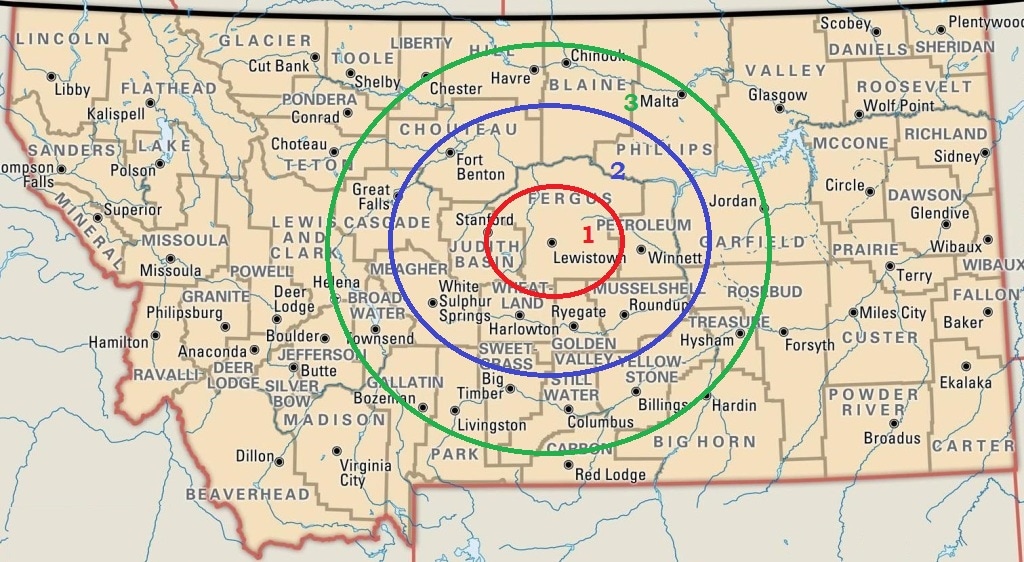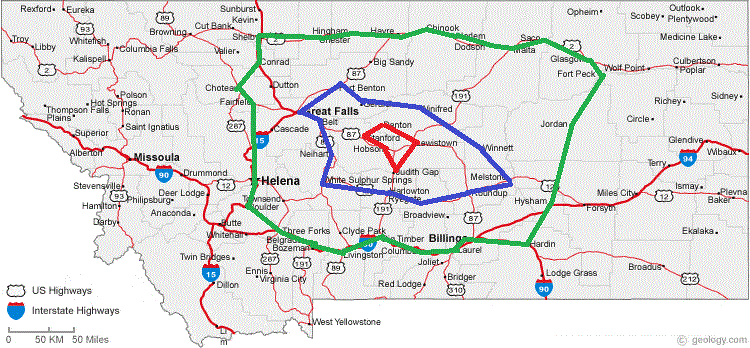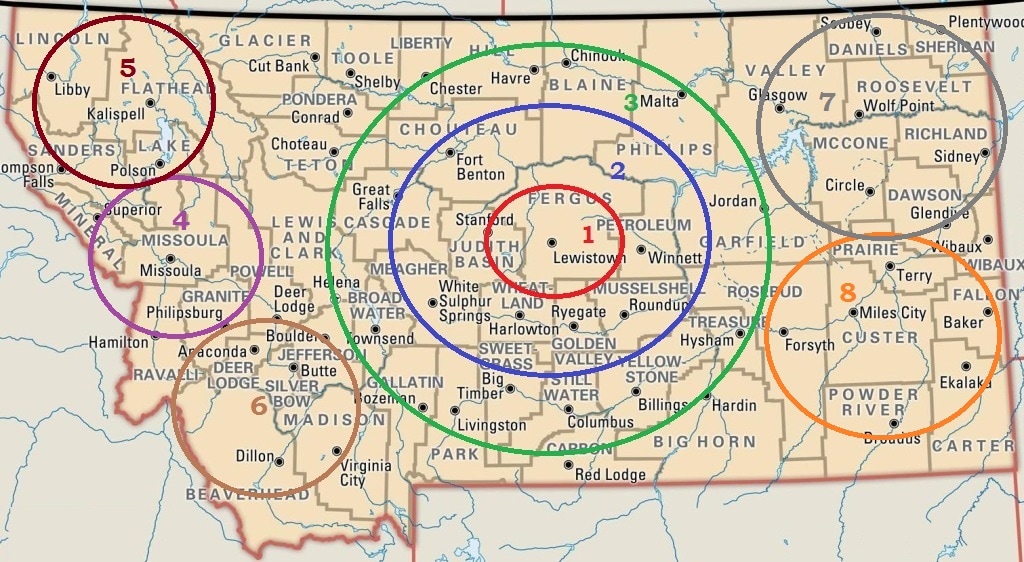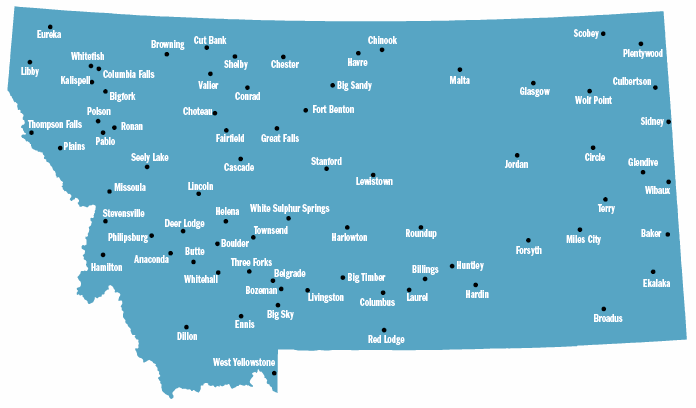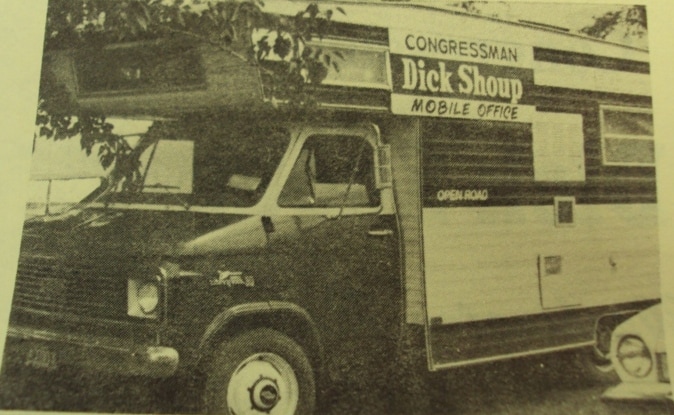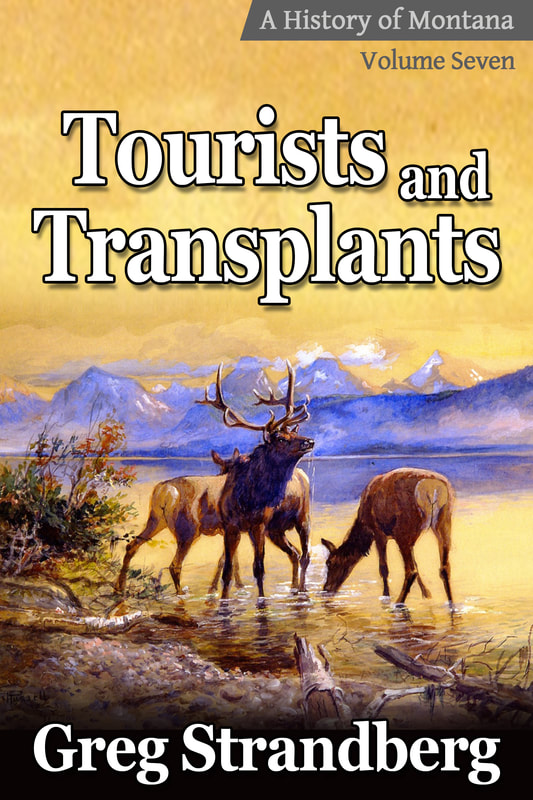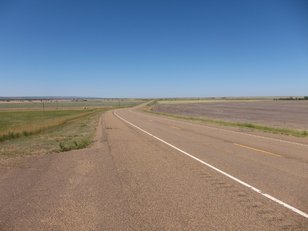 Somewhere in northeast Montana
Somewhere in northeast Montana
But doggone it, I get passionate about Montana politics.
If you were to run a statewide campaign in Montana, you’d need that passion.
You’d need lots of it.
Montana is 147,000 square miles.
It’ll take you 559 miles to travel the state from east to west and 321 miles to go from north to south.
Three-fifths of the state is in the east and is covered by plains consisting of rolling hills, wide valleys, badlands, and small mountain groups.
The other two-fifths are in the west and covered by flat, grassy valleys and mountains blanketed in pine, spruce, fir and evergreen trees.
Over 100 mountain ranges impede those travelling through the Big Sky State, and more than 50 major rivers dictate your course.
So it’s a daunting task.
Montana’s political graveyard is filled with headstones bearing the names of those that’ve attempted a statewide run and failed.
Rarely do they go much further than that.
For if you can’t run a statewide campaign and win, what can you do?
Either fade away into obscurity or go for a lesser office, like the regional PSC positions, a county commissioner gig, the legislature, or a 9 to 5 state department job in Helena.
Here are some folks that have run, lost, and done just that:
- Monica Lindeen (’06, ’16)
- John Driscoll (’08)
- Amanda Curtis (’14)
- Brad Johnson (’90, ’04, ’08, ’12)
- Bob Brown (’00)
- Bob Kelleher (’02, ’08)
And hey, some of those folks won statewide races.
None of them have won one from the trifecta, however – U.S. Senate, Governor, or U.S. House.
Those are the top jobs, and in that order.
Smart candidates would call those folks up on the phone and ask them about their experiences, what they remember, what they liked, what they hated.
You’d learn a lot.
If you called me up you wouldn’t learn shit.
I’ve never run a statewide campaign and wouldn’t know where to start.
But if someone asked me to figure it out, this is what I’d do.
The center of the state is Lewistown in Fergus County.
Now, Lewistown to Helena is 194 miles and that’ll take you about 3 hours.
Great Falls is closer, at 100 miles and about 1 hour and 45 minutes.
And Stanford is even closer than that, at 45 miles and about 45 minutes.
So let’s draw some circles.
Now might be the time to mention that there’s nothing scientific or hi-tech about my methods.
What I did was divide the center of the state into 3 sections that roughly align to our highways and interstates.
So if you were to take Section 3 there in green you’d have to travel 1,031 miles. If you drove that straight it’d take you over 17 hours.
We all know that a route like that would take days if not a week or more, however...what with the stops.
Section 2 comes out to 504 miles and about 9 hours while Section 1 comes to 157 miles and about 3 hours.
Now let’s hit up the eastern and western portions of the state.
So when we’re all done we have 8 sections to deal with.
That’s a lot for one candidate to do, and really – they have to do it.
No one wants to see staffers or volunteers…they want to see you.
Sure, getting staffers and volunteers out to those areas to hit up doors and drop off literature is a great thing, but if you’re doing ‘rallies’ you’ll need to be there in person.
And when we say ‘rallies’ we’re mostly talking about 20 to 30 die-hard political types that are going to vote for you no matter what.
Good luck winning a race with just those folks.
That’s how you turn out the base, getting just 40% if even that.
If you want to win you’ll need to reach the people that don’t go to rallies.
The nice thing is that most of these areas have newspapers, as you can see from this map.
Anyways, voter turnout in Montana isn’t anything to write home about, as you can see here with general (and primary) results:
- 2016: 74% (45%)
- 2014: 55% (33%)
- 2012: 72% (37%)
- 2010: 56% (32%)
- 2008: 75% (45%)
- 2006: 63% (34%)
- 2004: 71% (37%)
- 2002: 55% (29%)
- 2000: 60% (33%)
Almost all the time you’ll find that around 650,000 to 700,000 people are registered to vote but that just 300,000 to 500,000 actually do so (200,000 to 400,000 in off-years).
Don’t you think for one second that this is the voter’s fault.
It’s not – it’s your fault.
- You’re too boring.
- What you talk about is too boring.
- The issues you push and the things you ‘care’ about are too boring.
It’s why no one cares, about you or what you say or the office you’re running for.
Many people simply won’t know who you are or that there’s an election in the first place.
So that’s what you’re up against: a gargantuan level of indifference coupled with some of the worst political geography in the country.
Still want to run a statewide race?
If so, keep reading. If not, oh well.
In 2016 the following counties had the highest turnout:
- Judith Basin: 87%
- McCone: 86%
- Liberty: 85%
- Powder River: 85%
- Carter: 84%
- Golden Valley: 84%
- Jefferson: 83%
- Valley: 83%
So those 8 counties really get out there and vote.
That comes out to 16,700 people.
14 more counties have turnout of 80% or higher, and most of those are in the middle or eastern portion of the state (Daniels, Musselshell, Stillwater, Sweet Grass, Phillips, Treasure, Prairie, Garfield, etc.)
When we add up those 22 counties getting 80% voter turnout or more, we find that it equals 58,000 voters.
Now compare this with the cities.
- Lewis & Clark County had a turnout of 79% in 2016, or nearly 36,000 people.
- Silver Bow turned out the same percentage, with 17,000 people voting.
- Yellowstone saw a 75% turnout, or about 72,000 people.
- Gallatin had 74% with 56,000.
- Missoula had 74% too, with about 62,000 people.
- Cascade had 68% with 36,000 people.
So we find that all those major-city-counties turned out 279,000 people.
Gosh darn, if they all voted Democrat than this would be a blue state. But they don’t.
Now let’s look at the places that don’t vote:
- Big Horn: 55% (4,400 people voted)
- Roosevelt: 66% (3,800 voted)
- Cascade: 67% (36,000 voted)
- Mineral: 68% (2,100)
- Glacier: 69% (5,300)
There’s another 11 counties that had less than 75% turnout in 2016, and those counties saw 214,000 people vote.
Remember – Lake, Flathead, Sanders, Missoula, and Gallatin County all have 72-74% turnout rates.
Imagine what would happen if even 5% more of the people in those counties turned out.
On top of this we can get down to house district turnout, and we’ll use Missoula County as an example:
- HD 89: 4,734
- HD 90: 5,149
- HD 91: 5,266
- HD 92: 4,934
- HD 94: 4,973
- HD 95: 4,307
- HD 96: 5,286
So you get the idea.
Successful campaigns will dig into that district- and precinct-level turnout data to figure out which areas are worth their time, and which areas need their time.
Remember, every registered voter is like the person that walks onto the used car lot.
They’re ready to buy, you just need to sell it to ‘em.
When we see registered voters not voting we know it was because of bad salesmanship, nothing else.
Those people weren’t inspired, because you didn’t inspire them.
And just reading about someone or seeing them on the TV news or in some stupid attack ad isn’t inspiring.
It might be informative, but inspiring it ain’t.
Even going to their small area of the state to make an appearance might not be inspiring.
Chances are good they’re at work or too busy to see you anyways.
And yet every two years in this state someone is able to run a successful statewide campaign and win.
Sometimes this happens a few times every two years, like 2016 when we had 6 statewide offices up for grabs.
And that’s when the coattail factor comes into play, as well as the money situation.
So we’ve gone over a bit on which routes you might want to consider after dividing the state up into sections or regions.
We’ve gone over a bit on turnout and which areas really get voters to the polls, and which don’t.
Now let’s get into the money and other factors that might affect your statewide race.
First of all, the money.
There’s this terrible mindset in the Hilltop Public Solutions crowd that you have to get all your election services out of state.
This simply isn’t the case.
Let’s take Web Design. All these Montana companies can help you there:
- 406 Marketing & Design in Great Falls
- Eight Design Lab in Havre
- JTech Communications in Bozeman
- Bozeman Interactive
- Shortgrass Web Development in Great Falls
- Zee Creative in Billings
Digital Marketing services in Montana:
- Tadpull in Bozeman
- OutBound Digital in Missoula
- Partners Creative in Missoula
- Hagadone Digital in Kalispell
- Mammoth in Bozeman
- Big Storm in Bozeman
- Pintler Group in Missoula
A lot of the time Facebook advertising that’s been effectively targeted will have just as much of an impact as what these guys can do, and at a fraction of the cost.
In the future this will be how Montana primaries are won.
I believe Rob Quist’s Facebook advertising played a big part in getting him so much traction so early, and turning that into an unstoppable momentum that got him the March 5 nomination.
He spent $823 for that.
Printing is an easy one that most campaigns do in Montana now anyways.
In 2014 I used Montana Democratic Party printers in Billings, in 2016 I used Allegra and Denny’s Copy Center here in Missoula, and this year I’m using Missoula’s Alpha Graphics.
So we have your website, your marketing, and your printing.
That covers just about everything besides your travel around the state, food and lodging while doing so, and whatever you might pay yourself…as well as the payroll taxes that go along with that (and perhaps accounting services).
And maybe you’re paying your campaign treasurer too, or some kind of campaign manager or some staffers.
All that adds up.
In fact, salaries are one of the things that will weigh down your campaign’s finances more than anything.
I’d suggest keeping those costs to a minimum.
Lodging expenses can be reduced substantially by staying in receptive voters’ homes. Greg Gianforte took this route a lot during his gubernatorial run.
An RV or bus works well too, something that Amanda Curtis did in ’14. Many congressmen have instructed their Montana field office staff to do this over the years as well, mainly to stay in touch with voter opinion.
Act Blue works fine for garnering campaign contributions online, with only a 3.95% charge for each transaction and physical checks cut once a week.
I still like direct checks in the mail, myself, although voters often forget to include all the necessary reporting information, such as their employer.
I dunno, I’m winding this post down and I can’t help but feel I’m forgetting something, or a lot of somethings.
Like we said at the beginning, Montana is a vast state. Some call it high, wide and handsome, others an uncommon land.
It’s a rough land, often unforgiving and never to be taken lightly. Even a short drive will often take an hour, and with weather, anything can happen.
The state’s littered with those that’ve died making a statewide run – Blaylock, Fellows, Waltermire…to name a few – and I’m sure there’ll be more.
It’s a tough job, running a statewide campaign. Many who try and fail rarely try again.
Many never work up the courage – or the money that so often supplies that courage – to begin with.
But some do.
Maybe you’re one of ‘em.

